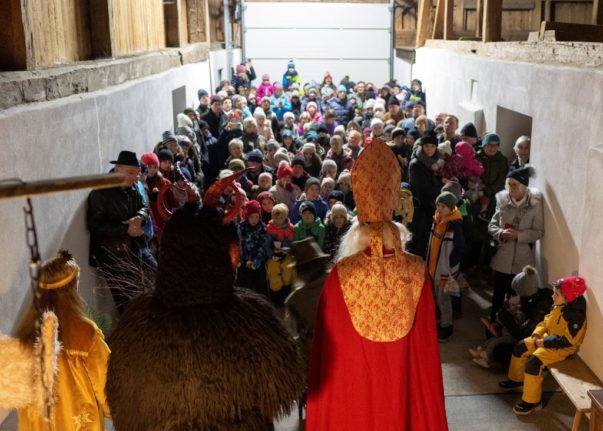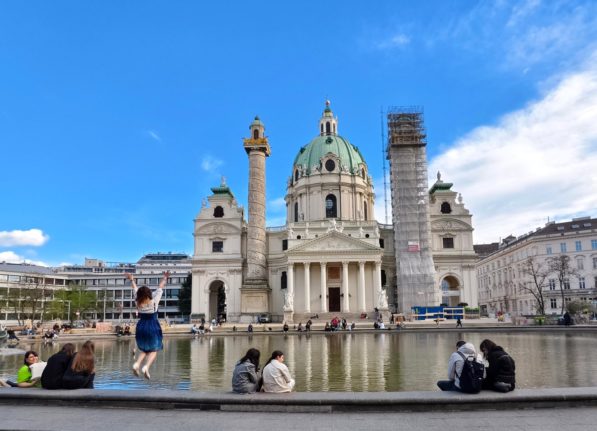Is Nikolaus the same as Santa Claus?
Though they have similar outfits, Nikolaus is not to be confused with Santa Claus, who Austrians call the Weihnachtsmann, or Father Christmas. They are two different people. In fact, many religious families try to focus more on Nikolaus earlier in December to ensure that Christmas is actually about Jesus’ birth, and not presents from an Americanised and commercialised Santa.
Austrian Christmas traditions: The festive dates you need to know
Who is Nikolaus, then?
Each year on December 6th, Austrians remember the death of Nicholas of Myra (now the Anatolia region of modern Turkey), who died on that day in 346. He was a Greek Christian bishop known for miracles and giving gifts secretly, and is now the patron saint of little children, sailors, merchants, and students.
Known as Nicholas the “Wonder worker” for his miracles, he is also identified with Santa Claus. Beliefs and traditions about Nikolaus were probably combined with German mythology, particularly regarding stories about the bearded pagan god Odin, who also had a beard and a bag to capture naughty children.
READ ALSO: How to celebrate Christmas like an Austrian
Why do children set their shoes out on the night of December 5th? Doesn’t he have any?
Of course Nikolaus has shoes. The custom began because the historical St. Nicholas had a reputation for leaving secret gifts, such as coins, in people’s shoes overnight. Kids traditionally put out their boots, though shoes or stockings will suffice for those without boots. Nikolaus then leaves a few little gifts or treats in them.
So who is Krampus? Is he different from Nikolaus?
In what is possibly one of the most unusual Christmas traditions in German-speaking countries, Krampus is the much scarier companion of Nikolaus – and the two visit Austrian, German, and Central European households together as a kind of “good cop, bad cop” duo.
Depending on whether children have been naughty or nice – they might wake up on December 6th to find that Nikolaus has left them treats in their shoes – or they might instead get a punishment from Krampus on December 5th, the night that both Nikolaus and Krampus traditionally come to visit.
While Nikolaus is a saintly, nice old man much like Santa, Krampus is a horned, scary anthropomorphic devil creature who visits the homes of Austrians and scares children who weren’t good kids during the year. Described as half-demon, half-goat in some legends, Krampus is also said to scare away the dark spirits of winter and is a very traditional part of local folk customs.
There are many Krampuslaufen (a sort of Krampus parade) in Austria and many, but not all, happen on December 5th. In them, people dress up as the demonic entity with chains and torches.

READ ALSO: German Advent word of the day: Der Krampus
And the boots have to be polished first?
Definitely. Dirty boots are unacceptable. Children polish their boots to show they’ve been good. They usually place just one boot outside their door so they don’t appear too greedy, though.
This is why your Austrian neighbours might leave their boots outside on the evening of December 5th.
One polished boot: Check! What happens next?
According to the legend, Nikolaus comes in the middle of the night on a donkey or a horse and leaves little treats – like coins, chocolate, oranges and toys – for good children.
He has a long white beard and wears a religious vestment that is white and red, similar to a bishop’s vest.
READ ALSO: 12 things you’ll only get once you’ve celebrated Christmas and New Year in Austria
What do naughty children get from Krampus?
This depends on different family traditions. Sometimes Krampus will simply leave a switch (of wood) in the boot, ostensibly for spankings, to show that the child doesn’t deserve a treat.
Other traditions are much darker. In some, Krampus himself administers a spanking with the switch on the night of December 5th and the naughty child wakes on December 6th to nurse their injuries.
However, some very dark stories involve Krampus kidnapping evil children – either to eat them or take them to the underworld.
READ ALSO: Here comes Santa Claus (with his satanic sidekicks)
Wow that’s dark! Doesn’t it spoil the fun a bit?
Certainly! Children were often quite frightened of getting a visit from Krampus rather than Nikolaus. That’s part of how the tradition is used on one hand to reward good behaviour, and on the other to deter misbehaving.
Does Nikolaus come again on Christmas Eve then?
No. Santa Claus, or the Weihnachtsmann, usually comes to Austrian homes – often in person – on Christmas Eve.
Frohen Nikolaus!
SEE ALSO: How long are Austria’s famous Christmas markets open this year?



 Please whitelist us to continue reading.
Please whitelist us to continue reading.
Member comments